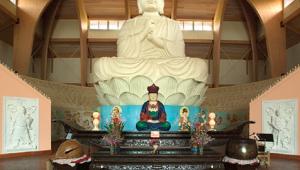Globetrotter
Shooting Indoors; How To Deal With Low-Light Conditions Page 2
Indoor Flash Photography
Sooner or later, we'll need to use a flash for our indoor pictures. If
we take our time and make a few flash and camera adjustments, we can balance
the light from the flash to the existing light for a more pleasing picture,
one without harsh shadows. Basically, the technique is the daylight fill-in
flash technique. Here's how to do it:
1) You'll need a flash unit with variable flash output
control; that is, +/- exposure control. You'll also need a tripod or IS
or VR lens (because of the slow shutter speeds you'll be using).
2) Turn off the flash.
3) In the Manual mode, set the exposure.
4) Turn on your flash and make an exposure with the flash set
at -11/3. If your picture looks too much like a flash shot, reduce the flash
output to -11/2. If it's still too "flashy," continue to reduce
the flash until you are pleased with the result.
This technique works because in the Manual mode, the flash will operate in the
Automatic mode.
 |
|
|
Indoor Fill-In Flash
Using the daylight fill-in flash technique mentioned earlier, I was able to
get a good exposure of my wife, Susan, at the National Air and Space Museum.
Shooting Through Glass
Adding to the challenge of shooting indoors is shooting through glass.
First, the light level is often reduced even further, as was the case when I
was photographing this jellyfish at the Monterey Bay Aquarium in Monterey, California.
Even lower light levels require us to boost the ISO even more than usual. For
this shot I set my ISO at 1000.
Second, we need to reduce the reflection off the glass as much as possible.
We could use a flash and shoot at a 45Þ angle to the flat glass panel.
That will most likely eliminate the glare from the flash, but we still may see
some reflections from other light sources.
Your best bet for natural light photography is to cup your hand around the lens
and hold your hand on or close to the glass. That technique will block out surrounding
reflections.
 |
|
|
When it comes to white balance in these situations, Auto is a good choice,
due to the possibility of mixed lighting conditions.
In choosing a lens, try a wide angle lens and small f/stop for good depth of
field.
In very low-light conditions, you may find that your autofocus camera will not
focus. In those situations, you'll need to switch your camera to manual
focus.
Undoubtedly you will run into challenges in your indoor photography but the
resulting pictures can be worth the care and effort needed to take them.
Choose The Lowest Practical ISO
As we increase the ISO setting on our digital camera, we increase the amount
of noise in our digital pictures. (Low-end digital cameras have more noise at
high ISO settings than mid range and professional digital SLRs.) With Photoshop
plug-ins like nik Dfine (www.nikmultimedia.com),
and with the Noise Reduction feature in Photoshop Elements 3.0 (www.adobe.com),
we can remove some of the digital noise. However, it is best to start with the
cleanest possible picture. Therefore, when setting the ISO, we need to start
at the lowest ISO settings to see which ISO setting will give us a shutter speed
fast enough to hand hold our camera without getting camera shake.
The basic rule for hand holding a camera is not to use a shutter speed slower
than the effective focal length of the lens. For example, we shouldn't
use a shutter speed slower than 1/100 sec when using a 100mm lens. If your digital
image sensor has a multiplication factor, you need to take that into consideration.
To illustrate, a 100mm lens on a digital SLR with a 1.6x magnification factor
"becomes" a 160mm lens. Therefore, with this camera/lens setup,
you'd need to use a shutter speed of at least 1/160 sec for a steady handheld
shot.
 |
|
|
From experience, I've found that my lowest ISO setting for handheld
indoor pictures is usually 200-400. This natural light shot of my son, Marco,
eating an ice cream cone was taken at ISO 400. At that relatively high ISO setting,
we don't see or notice the digital noise. That's because digital
noise is most visible in the shadow areas of a picture, and there are almost
no shadows in the scene.
Naturally, in very low-light conditions, a tripod is a big help to steady our
cameras. Here, too, we need to select a low ISO
for the least possible noise in the digital file.
Rick Sammon is the author of "Rick Sammon's Complete Guide to Digital Photography," published by W.W. Norton. He also recently completed two interactive CDs, "Photoshop CS for the Outdoor & Travel Photographer" and "Photoshop CS Makeovers," distributed by Software Cinema. For more information, visit Rick's website at: www.ricksammon.com.
- Log in or register to post comments

















































